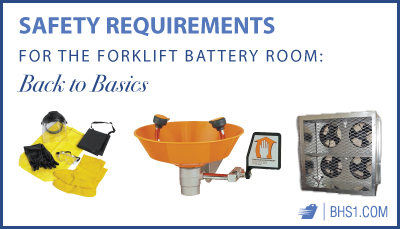We use cookies to make your experience better. To comply with the new e-Privacy directive, we need to ask for your consent to set the cookies. Learn more.
Safety Requirements for the Forklift Battery Room: Back to Basics
There are two very important reasons to maintain a safe battery room — to protect employees and to comply with federal and local regulations. Heavy-duty, ergonomic battery-changing equipment with abundant safety features helps every operation using electric forklifts to accomplish both these goals at the same time.
The Occupational Safety and Health Administration (OSHA) gives both general and specific guidance to battery room operators. The General Duty Clause of the OSH Act is the umbrella law that requires employers to "furnish to each of his employees employment and a place of employment which are free from recognized hazards that are causing or are likely to cause death or serious physical harm."
That description is crucial but vague, so let's look at those areas where OSHA specifies that death or harm could occur in a battery room:
-
During the battery exchange
-
Contact with spilled or leaked electrolyte
-
Unsafe concentrations of hydrogen
-
Contact with battery cells that causes burns
The first step in keeping employees safe is to have a designated battery-changing area that is well-stocked for foreseeable hazards. Smoking should be strictly prohibited in this space. Fire extinguishers, electrolyte neutralizers, a water supply, and a phone should be readily available. Finally, the charger should be protected from collisions with the trucks, as stated in OSHA standard 1910.178(g)(2).
Once the room is in proper order, it's time to address the battery exchange itself. Here are some simple ways to address the above-mentioned situations and prevent them from injuring your valued workforce.
1. Use Gantry Cranes or Operator Aboard Battery Extractors for safe exchanges.
OSHA specifies that facilities should use a lifting beam or equivalent material handling equipment when lifting the battery. The largest concern here is that a falling battery could cause serious injury, or worse.
Using heavy-duty Gantry Cranes mitigates that danger by safely and securely moving the batteries while workers stay out of the danger area. Operator Aboard Battery Extractors make the process even easier and more ergonomic by allowing machines to perform all parts of the process. The choice between these two systems will come down to your forklift fleet; are they configured for vertical battery access, or do they allow for side-extraction? Gantry Cranes can help with the former, while Battery Extractors are ideal for the latter.
2. Protect staff and equipment from electrolyte that has boiled over, dripped, or accumulated throughout the battery room.

The sulfuric acid that keeps forklift batteries running is dangerous stuff when it gets on skin (the same substance causes pitting in concrete floors, after all). Because of this safety risk, all staff should wear protective gear when handling lift truck batteries. OSHA-compliant safety stations should also be in easy-to-reach locations within the battery changing area.
Of course, electrolyte can also damage equipment and flooring. For this reason, battery room managers should invest in acid-resistant racking, flooring, and other equipment to prevent gradual degradation that can lead to major safety issues.
3. Hydrogen must be ventilated to stay at safe concentrations.
Because lead-acid batteries release hydrogen during charging, a monitoring and ventilation system must capture and remove the dangerous gas before it builds to dangerous levels. The BHS Battery Room Ventilation System activates and begins dispersing when it detects hydrogen at a one-percent concentration. This preventive action stops an unsafe buildup from ever occurring.
4. Take precautions when working around the tops of uncovered batteries.
Good training and best practices can keep staff from burning themselves due to electrical short circuits in battery cells. Keep tools and other metallic objects away from the tops of uncovered batteries. Staff should never wear metallic jewelry during the recharging process. Do wear rubber gloves for an added layer of safety.
Communicate with staff and address potential problems before they become serious.
Of course, the general duty clause applies to any hazard, so it is management's responsibility to review their battery rooms for any dangers that OSHA may not address directly. Good communication with staff can help supervisors understand potentially unsafe situations before they cause any harm. Going the extra mile to comply with OSHA can save operations from costly fines and injured workers, and that will give everyone in the workplace peace of mind.
References:
"OSH Act of 1970." OSHA. Occupational Safety and Health Administration, United States Department of Labor, 1970. Web. 30 Oct. 2017.
"Powered Industrial Trucks (Forklift)." OSHA. Occupational Safety and Health Administration, United States Department of Labor, n.d. Web. 30 Oct. 2017.
